A short, dignified video this time – nothing like the Mount Hagen extravaganza. Enjoy.

A short, dignified video this time – nothing like the Mount Hagen extravaganza. Enjoy.
As entrances go, that of Chief Sekor of Olal village, North Ambrym, into our lives was pretty memorable – striding towards us through the rainforest, clad only in a namba (waist belt and banana leaf penis sheath – see photos) and grasping his chieftain’s stick. We very firmly were not in Kansas any more. Where the hell were we and how the hell did we get here?!
We didn’t really know what to expect from Vanuatu. It’s well known amongst Australians as a very-slightly-more-adventurous-than-Bali honeymoon destination, with enough 5 star waterfront resorts to shake a stick at. But equally one of our fellow travelers in PNG had spoken glowingly of the still active kastom culture prevalent in the outerlying islands, and this really hooked us – the Mt Hagen show had been so incredible that we knew we wanted to see more. So (obviously), we googled what to do with ourselves in our 2 weeks there, and came across an entry for the “Back to Our Roots” festival in Ambrym, one of the country’s more kastom-oriented islands – contact Chief Sekor of Olal village for further information. Which we duly did (for future reference, one contacts chiefs nowadays via mobile phone and the appropriate way to address them is, simply, as “Chief”), to be wooed with the promise of Chief-ordained boat transfer from the airport and a place to stay (in the Chief’s village no less. Actually in his guest bungalows, but I’d rather avoid the word bungalow. Chief Sekor was a pretty imposing chap whilst bungalow conjures a vision of an aging Surrey golfer clad in slacks). All sounded pretty interesting but we hemmed and hawed a bit – the internal flight schedule meant the festival would need to take a big chunk of our available time in Vanuatu and there’s not THAT much else to do on Ambrym. Hagen fuelled, however, we decided to go for it.
Chief Sekor’s entrance made us pretty confident we’d made the right decision, and that was BEFORE we saw the dancing. Or heard about the pig.
Yep, the pig. As we kicked back with a nightly cup of kava (see tasting notes) we were informed that the festivities of the next few days would include a pig killing. Well, ok, not unusual in these parts. And that the pig would meet its end by being ceremonially clubbed to death (as per tradition) – by one of our fellow tourists. Wow. This was a surprise – not least to Patrick, the Sydney based financial analyst to whom that honour fell (unlike us lucky but lazy layabouts, Patrick had spent the last 6 months in correspondence with Chief Sekor planning out his holiday, and the festival, in some detail and the two had built up quite a rapport). The pig killing in effect raised Patrick to the status of Chief Sekor’s tribal brother. We were all pretty excited – and to be honest more than a little apprehensive – about the next day’s events.
The festival itself was wonderful but rather hard to describe. You can see a little from the photos and the video – but this was about as far from the Hagen show as a South Pacific tribal kastom event can be. There were about 10 tourists, and maybe 100 or so locals, gathered in a traditional clearing, lined with tree fern carvings and dappled with shade. The setting, the hypnotic drumbeat, the singing, the pounding dancing, all combined into a magical and heartfelt experience. The dances were clearly an active part of tribal life – the kids here learn them when they’re tiny and all can perform the steps by heart without pause – which doesn’t sound that impressive, maybe, until you realise that some of these dances go on for nearly an hour. In fact, the primary dance (the Rom dance – in the photos it’s the one with the masked and cloaked creatures) is one of the key mechanics through which a man can “grade take”, ultimately allowing him to become a village or even area chief – the other main mechanic being the killing of large numbers of pigs, in particular pigs which have been hand reared for 10 or more years to develop tusks which grow in a complete circle. Yep, being a pig round these here parts carries some responsibility.
As for the pig killing? Patrick looked dignified and rather brave in his namba, falling into the rhythm of the event with grace. But yes, it’s pretty upsetting to see a ceremonial clubbing – the pig arrives hogtied and fully aware of its impending doom, and the clubbing is enough to inflict pain (pigs really do squeal) but not death, leaving a slightly sour taste in this pampered Westerner’s mouth.
I’ve rarely, if ever, felt further away from home … but that was an overwhelmingly positive feeling. Roll on, new experiences.
There is a heirarchy of loos. At the rarified end come Japanese Toto toilets, complete with recorded sounds of rushing water; heated electrically raising and lowering seats; directable, remote controlled water jets; and integrated hot air dryers. In the middle come western loos, bog-standard if you will. Then come the rustic French. After that the traditional Indian. Then come the full spectrum of long drops, followed by short drops. After that comes the native bush / hole you dig yourself. Bottom of them all is the wetsuit.
There are special cases, however, where we are prepared to make an exception to the grading system, and that is The Loo With a View. Our first, I think, was on a trip we made to Guatemala a few years ago. We made the exciting discovery that sitting on a bush toilet is considerably less unpleasant if you have sight of a (perhaps gently erupting) volcano. Since then, we have been on the lookout for new and exciting examples. There was one in the Everest Hotel in Nepal with a view of Everest and Lhotse. There are the men’s urinals at Felix’s bar in the Peninsula Hotel in Hong Kong, with porphyry units set against a glass wall looking out over the Hong Kong skyline. Once you start looking, you spot them surprisingly often.
Today’s example comes from Ambrym. Perched among the trees on the edge of a cliff – a rather incongruous western-style porcelain throne with a hole smashed in the bottom giving access to the short drop below. No seat (naturally) but a bucket flush. Bring your own paper. So far so bad. However, more than making up for it all is a wonderful view out through the trees over the crashing surf to the ocean and the islands in the distance. Four stars.
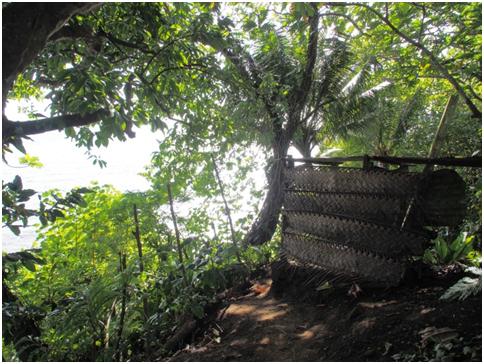
[The loo, Vanuatu]
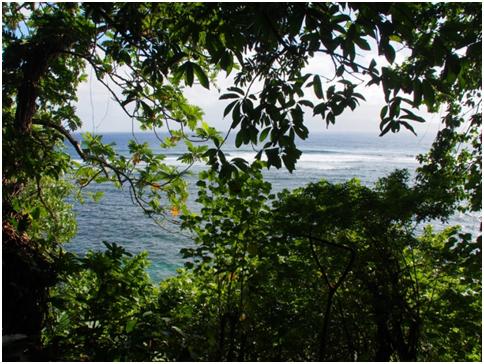
[The view, Vanuatu]
Boy was I glad to see the meat grinder.
Traditionally, an intrinsic part of making kava is the chewing – the root of the kava plant is passed out in chunks to a small group of friends and honoured guests, masticated thoroughly, spat out into a bowl, mixed with water, filtered through a cleanish sarong and drunk. I had been invited to watch the kava being made, and the presence of the new-fangled, hand-powered meat grinder meant that I wasn’t about to have to drink too much of other people’s spit.
We are on the north tip of the volcanic island of Ambrym in Vanuatu, in Chief Sekor’s village on top of the cliffs looking out over the reef towards Pentecost Island, famed home of the Pentecost land divers. It is a very special place. We are a three hour boat trip around the coast from the nearest rough airstrip, and I am about to have my first bowl of kava:
They are very proud of their kava on Ambrym. For some reason, the delicacy hasn’t travelled.
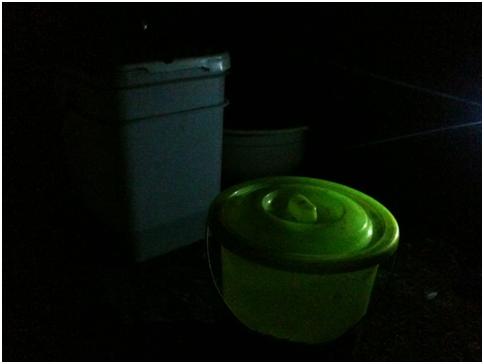
[A truly artistique iPhone shot … of a pair of buckets]
Our parting gift from Papua New Guinea, perhaps aptly, was an unexplained delayed flight and a resulting missed onward connection in the Solomon Islands.
Forced to stay in Honiara for a night we were determined to make the most of it: we had an excellent Japanese meal, a swim in the hotel pool, a good gym session and two very hot showers. We booked some air tickets, bought some snorkels and a local SIM card and updated the blog. We also rode up and down in the hotel funicular cable car and made two valiant attempts: one to find a famed local bakery / cappuccino bar (no bread, or coffee) and one to snorkel on a local wrecked freighter by booking a taxi and heading off in its general direction with our eyes peeled (no luck).
We were feeling a little twitchy. PNG had been amazing, but we (or perhaps more succinctly, I) had been ground down by the difficulties of getting around and we had, as a result, gone to less places than perhaps we should. Given that we are extremely unlikely to go back, this left us feeling perhaps a little guilty at the wasted opportunity. There is a long essay brewing somewhere about how to pace yourself on long trips, so we won’t go into that here. Let’s just say that we were keen to get on and do
things.
So we headed off to Zipolo Habu Resort on a small island in the Western Provinces keen for some action, only to find one of the more chilled out places in the world. Joe, the owner, constructed the place himself out of bush materials, slowly building it up over 30 years. There was beer in the fridge and fish in the sea – what more could anybody ask for? We had a great time, and we filled the time. I went scuba diving for a day: huge coral walls, sharks, two wrecked WW2 fighter planes. We went on a pretty amazing WW2 relic tour – snorkeling on a sunken Japanese freighter, lobster sandwiches on the pier for lunch, climbing on an American tank and half visiting an underground field hospital (let’s just say that you would have to be really, really sick to want to go inside). We went to a real life Skull Island! (yarrrr, me hearties!). We drank beer with a group of travelling yachties…
And yet, slightly spoiling the experience were the ants in our pants. You see, newly-made palm frond roofs sometimes still contain fire ants. And fire ants are tiny enough to fall through mosquito nets. And fire ant bites HURT LIKE HELL! And three nights in a row being bitten in the arse start to take the shine off anyone’s sense of humour. And the other guests – mostly Australian retirees – were very nice company and all that, but we were left with a mild yearning for adventure.
Little did we know how soon that would appear … next stop, Vanuatu!
PNG can be a pretty scary place at times. It has a terrible reputation internationally, particularly in Australia which is close enough for the newspapers to carry articles about the constant local tribal wars. Probably the best vignette to sum up the reality, however, happens about twenty times a day: you will be walking in the street when up comes a large Melanesian man, scruffily dressed, pretty dirty, bearded, deeply aggressive looking and with dark red betel-stained teeth. Oh, and he’s carrying a two foot machete. He stops and looks at you. You smile as confidently as you can muster, say a cheery good afternoon and cross your fingers. He pauses, then breaks out into a huge grin, introduces himself as something deeply biblical (like Isaac or Joshua) and is instantly your best friend. It’s bizarre, slightly unnerving yet rather wonderful.
The tribal wars which make the newspapers are typically fairly ritualized affairs fought, say, on the local football pitch – in the days before guns, they used to attract spectators. Although collateral damage regularly involves the burning down of villages, it is pretty rare for an outsider to be caught up in them. Compensation for wartime killings is typically made in pigs and the systems of payment are relatively sophisticated: we recently saw a long line of stakes by the side of a road stretching towards a distant marker – each stake signifies a pig, and both sides visit the site at differing times, adding and removing stakes and moving the marker back and forth. Once the stakes reach the marker the negotiation is complete, the pigs are paid and everyone is friends again. And at no point does anybody call the police – again, either great or terrible, depending on how you look at it.
The other issue which surprised us rather was the cost of everything. Or rather, the value of everything. We don’t mind slumming it, and we don’t mind paying up for quality. What really gets our goat is overpaying for crap. There are virtually no mid-range hotels, and very few backpacker joints that you would want to trust your backpack to. Mining companies fill up the few hotels inflating prices – you can easily pay US$100+ for a hotel room that would cost you about $40 in the US, if anybody were prepared to stay there. Two chicken drum sticks and half a plate of oven chips will set you back $22. Internal flights (which you need to get anywhere at all, as there are few roads) can be US$700 each, one way. We spent many thousands of dollars in our three weeks here, and were by no means rushing around.
PNG has been utterly blessed with an extraordinary fertile climate – everything grows everywhere and seemingly everybody has a garden producing an excess of coconuts, bananas, sweet potatoes, passion fruit, papayas etc.. Fish jump out of the rivers for lack of room. Jungle runs rampage on uncultivated land, fence posts sprout leaves – it’s incredible. So why do they charge tourists the earth for crappy imported noodles, crappy imported tuna, crappy imported peanut butter and (actually quite nice) imported jam? The roads are typically third world country bad, but don’t reach into the interior from the capital. Everything has to be flown in or shipped the long way round, and this boosts the prices yet further.
There is an argument that there is no need for enterprise, given the incredible fertility and the resulting ease with which subsistence affluence can be attained. There is another argument that the “wantok” system that allows one’s kinsmen to share in one’s good fortune not only provides an effective social security net, but also discourages individuals from working hard as they are not allowed to keep the gains. Post colonial hangovers of an unsuitable Westminster-style parliamentary democracy and (perhaps?) a post-colonial inferiority complex can’t help.
Yes, everybody is extremely friendly (while warning you to watch your back), but a smile doesn’t really soften the blow of (for example) a $400 one-way three hour minibus transfer or (and I think this was an accident, and I certainly didn’t pay it) $60 for four bowls of thin vegetable soup.
Apologies for the rant. This was written just after our hotel (for which we paid US$ 900 for three nights, during which we ate bread, jam and bananas two meals a day) just “forgot” about our agreed transfer to the airport, and eventually got us there ten minutes before the flight was due to take off. The upsides in PNG are amazing, however, and make the whole thing worthwhile (for example, the check in people at the airport were extremely helpful, waved us through, and put our backpacks on the plane themselves). You’ll just have to look at some of the other posts to describe the good times we have had here!
I am no writer, and I don’t feel particularly proud of my previous, halting attempts to describe the Mount Hagen show. I am certainly not a videographer, but I am strangely proud of this:
By the way, the “less respectful” part of the video is due to the choice of the music. The chanting, singing, stamping and drum beating was utterly mesmeric but nigh on impossible to capture cleanly with my little Olympus. As a result I wrestled long and hard with the choice of soundtrack – something appropriately tribal but geographically incorrect? Something vaguely electronic but appropriately rhythmic? Cop out with something abstract? Lucy finally came to the rescue (as she so often does) by suggesting the song we used. So wrong, it’s right. Right?
OK, so this is our luxury accommodation in the outskirts of Port Moresby, ugliest and most dangerous city in the South Pacific, for our last night in PNG:
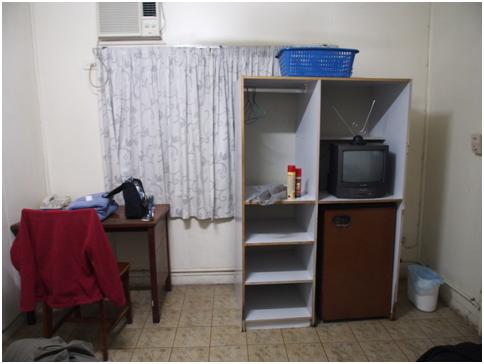
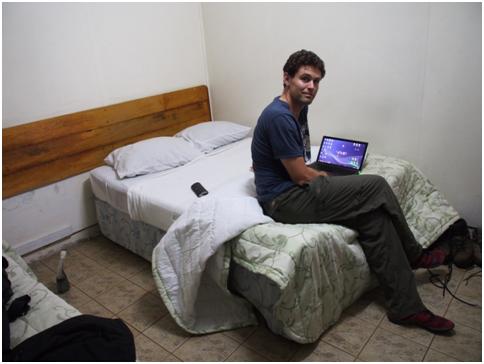
Contents:
So – what price this room? Answers through the comment facility, winner gets a FREE NIGHT at this luxurious establishment*.
By the way, the price we’d been quoted was rather less (some confusion as to whether 2 people could fit into a single room…..). That’s the price we paid – so we left PNG with a rather real threat of police action descending on us. My father would be proud 😉
* You’re paying your own airfares though. Cheapskates.
The first rule of going out at night in Port Moresby is: don’t go out at night in Port Moresby. Although we joke and complain about being cooped up behind razor wire in hotels elsewhere the country, in Port Moresby (henceforth called PM) it is pretty necessary. Our taxi driver put it best: “I give my passengers rules. The first rule is, never get out of the car. Once an Irish lady got out of the car to take a photograph of the parliament building. She got robbed. At knife point. At ten in the morning. And I had to risk my life to save her – the robber was asking his friends for help in killing me, but they couldn’t be bothered. NEVER get out of the car. NEVER.”
This little speech was delivered on our way out to dinner on our last night in PNG. The fact that the robbers are quaintly called “raskols” in Pidgin doesn’t diminish the fact that this is a very dangerous city, known as one of the least liveable capitals in the world. We were stuck in a dingy, expensive hotel and wanted to stretch our wings a little. We had also had a restaurant recommendation from an excellent guide we had met in the Highlands (hi Nitin!) and wanted to try out “Dynasty” restaurant – it is meant to be one of the best places in town.
Let’s set the scene a little. One of the first hits you get when you google restaurants in PM is a blog post called Lower Your Expectations; Dynasty is a cookie cutter Chinese restaurant. In a shopping mall. While we are not natural mall rats, the advantage of a mall in PM is that you can (you guessed it) put a high fence round the outside and ring it with paramilitary-style security guards. This allows expats to wander round relatively safely with a particular mixture of homesickness and nostalgia – a wistful longing for home, as they knew it in the late 1980s.
Dynasty did us proud. No Alexis Carrington-style shoulder pads, but an actual, true-to-life half-decent Chinese restaurant. It was a little empty, seeing as we went at about 6pm so as to get home before the streets got too lively, but we had our dinner, had our beer, called a reputable cab to take us home, and nobody died.
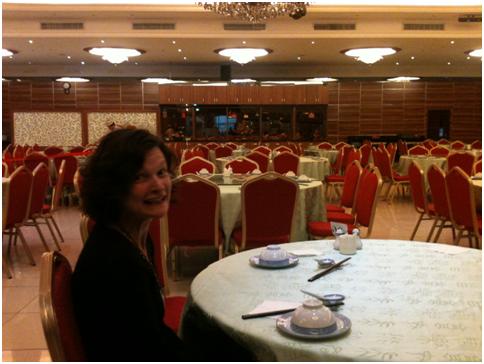
[Lucy in busy, bustling, happening Port Moresby]
While we on the topic of shopping, it was while we were wondering round the mall with our ice creams looking in shop windows (Jesus, what has happened to us?) that we noticed the prices of everything. For example, an iPhone 4 was on sale in a shop for just over US1,250. Some questions: who in PNG can afford to buy them at this price? What heinous import duties are lining officials’ pockets to jack them up to that level? What must the locals think when every foreign student backpacker who passes through PNG has one in his pocket? The mind boggles.
Ahhh, Kumul Lodge. So right in many ways; so frustrating in so many others. It’s like PNG in miniature.
We headed there just after the Mt Hagen show – as you can imagine, we were still on a bit of a high after that. We’d plumped for Kumul as our destination as the alternative, Tari, sounded potentially a little far to travel and a little dangerous (rumours of an ongoing tribal war), and Kumul sounded nice – lots of birds of paradise, great hiking including to some local villages and a beautiful location not far from Mt Hagen. All of which was true.
Well, sort of. And there’s the rub.
There were birds of paradise – 8 species in fact. It’s just that only one species lives at the same altitude as the lodge, and for the others you need to take a tour to see them. Cost: $150 per person. There was hiking available – but only really along the road and a few short trails around the hotel; the other trails were never used, not really maintained and virtually un-passable (we tried: see “Mt Hagen Running Man”) and of course you needed to take a guide. The closest village was actually 10 kilometres and over 1,000 vertical metres away from the hotel – only walkable if the lodge provided a one way car transfer – and they didn’t have a car (we managed it by hitching a ride – with some other tourists one way and in a truck on the way back). Food was available – unless you were late or they forgot about you (both happened) – including a complimentary plate of fruit. Only it wasn’t complimentary, it was an additional $10 per mealtime.
Just enough minor annoyances to really take the shine off what should have been a great place – yes it was beautiful, yes the bungalow was lovely and rustic, and YES we saw birds of paradise. We both just ended up wildly frustrated by the place.
And yet, in some ways, we talk more about Kumul than we do about many of the more spectacular places we saw in PNG. We think that maybe in some ways, it provided a truer vision of the country than almost anywhere else we stayed.
A few vignettes:
The village down the road was abandoned and burned down. There had been a land dispute between villagers which escalated and ultimately culminated in some shootings. The entire village took sides, and war kicked off. Ultimately, the place became so dangerous that every single family abandoned both the village and their ancestral land (and only source of income) to stay with relatives. A man from Hagen was hired by one side to burn down the remaining houses – the other side found him and killed him. Negotiations were currently taking place as to appropriate reparations – in the form of live pigs to be transferred, and only once this had been agreed would any of the villagers be able to return home. This wasn’t considered at all unusual locally, other than the fact that the dispute was within just one village, rather than the usual two.
Our guide, Max, was a born naturalist with a burning ambition to start up his own eco-tourism business centred around an orchid garden. Only he couldn’t get any backing. Partially because under the PNG “wantok” system, he owed his loyalty to one of his relatives, the owner of Kumul Lodge – who preferred that Max spend his time guiding tourists and maintaining the grounds of the lodge. Partially because Max was wildly unrealistic – I’ve never met a man so bitter about the refusal of local people to work for him on the promise of future payment as and when the orchid garden took off. Partially because the whole idea is so flawed – who’s going to come to see a 40 foot square orchid garden, however nice, when it’s miles from anywhere and smack in the middle of Max’s sweet potato crop? But how do you work that out when you live in a country with minimal education and a staggering 75% unemployment?
We asked for the bill on our last day and were a little surprised when it took 20 minutes to produce. And then it was wrong. The reception lady simply couldn’t add. I’m not being unkind when I say that, rather it’s a simple statement of fact. Up until about 50 years ago, the PNG counting system consisted of 1, 2, 3, many. Given the relatively limited amount of cash trading, that system still works pretty well for much of the population and the basic numeracy skills that we take for granted are just not that widespread. Most adults over the age of 30 probably weren’t taught much (any?) maths and can’t do even basic sums without the aid of a calculator.
Our airport transfer, which we carefully arranged with the lodge manager the evening before. They forgot about it. We managed to make the plane, but only because they were able to speak to one of their wantoks down at the airport and get us ticketed (we arrived 10 minutes before the flight took off).
I could go on, but I won’t.
Suffice to say that Kumul, like PNG, got under our skin. I wouldn’t have missed it for the world.